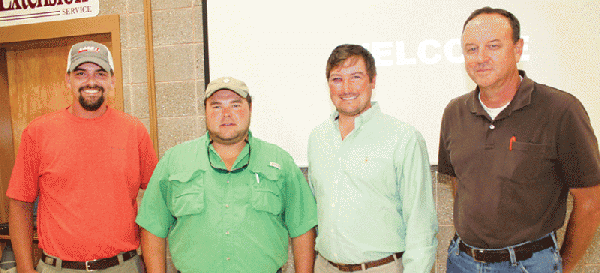

The Cotton Seal
This year marks the 50th anniversary of the Cotton Research and Promotion Act, a landmark grower-financed measure that saw the creation of Cotton Incorporated and a dynamic marketing program that birthed one of the most-recognized commercial trademarks, the Cotton Seal, and one of the most successful consumer marketing campaigns ever, “The Fabric of Our Lives.”
And millions of dollars have flowed through Cotton Incorporated to fund hundreds of research projects to further unlock cotton’s secrets and enable producers to grow the crop more efficiently and profitably.
But no one could have foreseen a half century ago the dramatic changes in cotton’s fortunes that have taken place in recent years — precipitous declines in acreage that resulted in fewer bales produced and fewer dollars going to the research and promotion program, all exacerbated by loss of market share to cheaper synthetic fabrics.

BILL GILLON
Check Current Cotton Futures Prices
“American cotton has enjoyed a lot of success with this program,” says Bill Gillon, president and chief executive officer of The Cotton Board, which administers the program.
And as the next half century begins, efforts are being launched to make Cotton Incorporated programs even more targeted and efficient, he said at the joint annual meeting of the Mississippi Boll Weevil Management Corporation and the Mississippi Farm Bureau Federation Cotton Policy Committee.
“Our theme going forward is ‘Renew Your Faith in Cotton,’” he says. “We can take pride in the many great things we’ve accomplished — we’ve enjoyed a lot of success with this program, and we have a lot more in front of us. The theme for this anniversary year is ‘Renew Your Faith in Cotton.’”
But for the immediate future, the challenge is to deal with shrinking funding, to get the most bang for every buck, Gillon says. From a budget high of $83 million three years ago, this year’s number is $76 million, and the tentative 2017 budget is $70 million.
“Over the years, advertising is the part of the research and promotion program where we’ve spent the most money, and we’ve had some extremely successful campaigns. But even though we can put the best products on the shelf, we still have to get consumers into the store and make a buying decision.
Convincing consumers to choose cotton
“We’ve done a good job of convincing consumers to choose cotton — in surveys, 80 percent say they prefer cotton, they want to wear cotton. But in the last 10 years, it has become more difficult to translate that desire into actual purchases. We’re further honing our message to convince consumers to act on their preference and buy cotton products.
IT’S FREE! Stay informed on what’s happening in Mid-South agriculture: Subscribe to Delta Farm Press Daily.

Taylor Harris, from left, Kosciusko, Miss.; Cody Parker, Pelahatchie/Morton, Miss.; Kevin Brown, Farm Bureau, Jackson; and Ted Kendall, Bolton, Miss., were among those attending the joint annual meeting of the Mississippi Boll Weevil Management Corporation and the Mississippi Farm Bureau Federation Cotton Policy Committee.
The latest TV campaign, “Cotton: It’s Your Favorite for a Reason,” started last year, and has racked up good response numbers, Gillon says. “But in the future, TV advertising will be less a component of our promotions.” The reason? “TV has become so costly, and with hundreds of channels, it’s much harder to target the demographics we want. So, more of our advertising and promotion dollars will be going into digital and online advertising, which will allow us to better target the people we want to reach.”
Another key focus: “We have to find new markets and new opportunities for cotton,” Gillon says. “We can’t just rely on doing the same things we’ve done for years. We have a strong program to use cottonseed as a supplement to dairy cattle rations, and we’re trying to expand into other markets, such as fish food, using ultra-low gossypol cottonseed. All this can bring extra revenue to the cotton producer and enhance margins.
“We’re working with seed companies to incorporate this technology into their varieties. We’re promoting the use of cottonseed oil, the use of cotton linters in a range of products, including noise-dampening wall covers, and the use of cotton burrs as a wood substitute in construction products.
“We’re also enhancing and finding new uses for cotton in non-woven products,” Gillon says. “We’re using short fibers in medical supplies, hygiene products, baby wipes, medical gowns, etc. This area is dominated by synthetic fibers, primarily because cotton is more expensive. We’re trying to expand our share of this market. There’s an operation in the Delta that uses unbleached virgin cotton in non-woven products — when you don’t bleach cotton, you get different fiber characteristics. We have several research projects in this area, and we’re optimistic we can do some good here.”
Emphasis on research will continue
Cotton Incorporated will continue to focus on research, he says, from seed going into the ground all the way through to the point a consumer buys a cotton product.
“We spend millions of dollars on agricultural projects designed to help America’s cotton producers. This division oversees about 400 outside research projects from the ground up, focused on production, improving the cost efficiency of growing cotton, and enhancing the value of fiber and cottonseed.

Engineered Fiber Selection System MILLNet software assists textile mills in utilizing high volume instrument (HVI) data available on every bale of U.S. cotton. It allows mills to purchase and spin cotton fiber into yarn more efficiently.
“We also assist in communicating new technologies to farmers and help develop new cotton varieties. We have programs designed to enhance the ability of cotton fiber to compete in the marketplace. We tested more than 50,000 fiber samples in 2015.”
Assistance is also provided to breeders in identifying varieties with the best fiber traits, Gillon says, and to act quickly to resolve issues that arise. “In March there was a discussion about HVI, new varieties being developed, and a slight slip in uniformity, and we were able to shift priorities to target more money to uniformity research.”
Other Cotton Incorporated specialists analyze and predict fashion trends.
“They attend meetings all over the world, and produce two seasonal trend forecasts about what people want to wear and how cotton can play a major role in products to meet those demands. They look at fabric construction, analyze a wide range of fabrics and fashion trends, and create cotton fabrics that will compete with others in the marketplace.
“In 2015, Cotton Incorporated had 576 requests for over 8,200 fabric selections. Today there is a color for every fashion season — there now are eight of those seasons in a year — and we have to be sure cotton fabrics can match the color all the fashion houses are looking for. CI produces those samples and swatches and distributes them to the fashion industry.”
Important upcoming events: Delta Farm Press Calendar of Events
Cotton research has developed wrinkle-resistant fabrics and other enhanced products, Gillon says. The latest is trans-dry, breathable, moisture-wicking, storm technology cotton products that can compete with synthetic products in performance categories. “More than 226 companies around the world are now licensed to use these cotton technologies, and we’re getting our foot in the door in a lot of categories that we weren’t in for years.”
Influencing key decision-makers
An important function of Cotton Incorporated specialists, he says, is to “talk to people who make decisions about buying and using cotton — supply chain marketing. They go where these key people are, Asia primarily, places that make fabrics, cut and sew operations, working to convince those companies to buy and use cotton.

Cotton Incorporated consumer advertising will increasingly be targeted to digital media.
“This is probably the single most important place where we can have the greatest impact on cotton consumption around the world. CI has staff dedicated to influencing these supply chains; in 2015 they had more than 800 meetings in over 30 countries, meeting with over 400 companies.
“CI staff also conduct many educational programs aimed at those who do sourcing for companies that make fabrics in overseas plants; they teach these people the best ways to use cotton, and how cotton can be the best fiber for them to use in their products.
“In 2015, there were 52 educational workshops attended by more than 1,700 people from 177 companies,” Gillon says. “We also have an online educational program, Cotton University, to teach people how to use cotton, a very efficient way to get our message out to the world. It now has more than 14,000 registered users.”
A software product created by Cotton Incorporated — Engineered Fiber Selection — is primarily used by spinning mills. “If a spinning mill incorporates this technology, then they prefer U.S. cotton, because the EFS program gives them information on the cotton bale that greatly enhances the efficiency of their operation. Chinese mills that have this software use 60 percent or more U.S. cotton. It’s great way to promote U.S cotton around the world.”
About the Author(s)
You May Also Like




